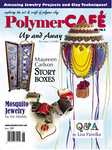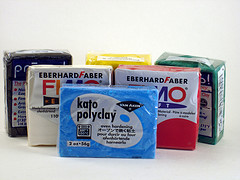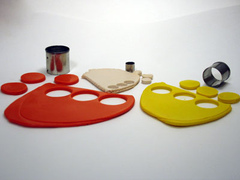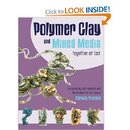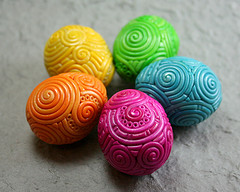Review: Sculpting Mythical Creatures out of Polymer Clay
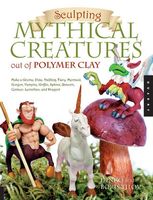
It's hard to believe it's been almost 10 years since I stumbled upon polymer clay. Hubby and I were on vacation, and I saw the Klutz books Incredible Clay Book
and Create Anything With Clay
in a toy store. I quickly realized polymer clay wasn't just for kids and fell in love with it. But when I went looking online for more information, I didn't find much. Polymer Clay Central was about it back then. So I spent hours working through various of their tutorials, trying to figure out what to do with this new and amazing material. And I clearly remember one of those tutorials was Dinko Tilov's How to Make a Bird with Teeth.
Dinko Tilov is still working with clay, and after a successful first book, he has teamed up with his brother Boris to write another. Their new book, Sculpting Mythical Creatures out of Polymer Clay (Quarry Books 2009), includes instructions for making 13 different creatures.
Overview
The book starts with a too-brief introduction to clay. I would have liked to have seen a discussion of which clay brands would be best for these projects. They mention tools to use — specifically the taper-point and cup-round clay shapers — but they don't include pictures of them. Granted, they say these specific tools aren't required... but it's hard to substitute something else if you don't know what they look like. (Here's a pic of the clay shapers on their website in case you're curious.) I also wish they had given more information, either in the intro or in the individual project instructions, on which wires to use for armatures, since the gauge and type of wire can make a lot of difference in its strength.
Following the intro, the book gives step-by-step instructions for making thirteen different polymer clay creatures, including:
- Gnome
- Pixie
- Halfling
- Fairy
- Mermaid
- Gorgon
- Vampire
- Griffin
- The Sphinx
- Unicorn
- Centaur
- Leviathan
- Dragon
If you're into mythical creatures, you'll likely find several projects here that strike your fancy. While some of the projects just don't appeal to me (the fairy and mermaid don't seem especially dainty or pretty), I do like the halfling, griffin, unicorn, and dragon projects. Still, I felt like Dinko Tilov's first book, Creating Fantasy Polymer Clay Characters, had a more charming collection of characters. Both books use glow-in-the-dark eyes, which I'm not crazy about, but it's easy enough to substitute another method of making eyes.
The projects progress from easiest to hardest, building on techniques demonstrated in previous chapters. For example, the armatures get increasingly more complicated as you go through the book, ranging from the armature-less gnome in the first chapter to the multi-appendaged dragon in the final chapter.
Each project includes:
- A time estimate for completion. (I really like this. Granted, the project I tried took me much longer than their estimate. But I am kinda slow!)
- A poem introducing the creature. This is a cute idea, and makes me want to write poetry for all my characters.
- Lots of excellent step-by-step photos and directions (seems like it has more photos than most books).
- A "variations" page, showing more creatures that could be made by simply changing colors, tweaking expressions, etc.
The book has lots of special touches. There's a chart that shows how changing facial hair on the same head can make a variety of characters. I love stuff like that. I like the stories & poems about the characters and the humor used in the instructions. It's a fun read — maybe not as much fun as a Christi Friesen book — but a lot more fun than the dry textbook style some craft books have.
I like the fact that they used clay characters as illustrations throughout the book — for example, there's a clay character holding a scroll who introduces each chapter. The fun way they made their characters come to life tempted me to start on a kids' book with some of these characters in starring roles. (Maybe I'd even have it done by the time my little one learns to read!)
I think my biggest complaint about the book is that it's lacking in finishing details. It doesn't show much texturing or smoothing, things that can make the work look a lot more professional. Some of the finished project photos in the book even have fairly obvious fingerprints. So while the book does a really good job of showing how to make armatures to create structurally-sound sculptures, those sculptures don't look especially polished.
Summary
- Title: Sculpting Mythical Creatures out of Polymer Clay
(Quarry Books 2009), by Dinko and Boris Tilov
- Price: $16 + shipping
- Pros:
- It's a fun read: each character has his own poem, and there's humor mixed in with the instructions.
- Great step-by-step photos.
- "Variations" page at the end of each chapter gives encouragement and guidance for tackling your own versions.
- Good info on armature and sculpture-building basics.
- Cons:
- Doesn't cover much detail finishing work (texturing, smoothing, etc.), so the end results don't look especially polished.
- Characters aren't as charming as those in Tilov's first book, Creating Fantasy Polymer Clay Characters
.
- Who It's Good For:
- Anyone who wants to learn more about making armatures & structurally-sound sculptures.
- Fans of Christi Friesen-style writing will probably enjoy the poems and humor in this book.
- Older kids should be able to do these projects, especially if an adult helps with the armatures.
Read another review of this book (and possibly win a copy) here.

